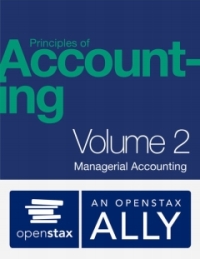Question
Below you will find information from Tesla, Inc. management and the work the accountant has done. Please answer the following questions for each of the
Below you will find information from Tesla, Inc. management and the work the accountant has done. Please answer the following questions for each of the two situations: 1. Is the accountants calculations and recommendations to management, correct? 2. If not, what should the calculations and recommendations be?
Management for Tesla, Inc. is trying to increase profit. They have the information they would like from the accountant. First, they realize it is impossible to produce enough of their products to meet demand. They would like to know which product makes the highest contribution margin. Second, they are thinking about expanding a few of their products instead of producing and selling them as parts.
A. The constraint at Tesla, Inc. is an expensive piece of machinery. The three products listed below use this constrained resource.
| A1 | B2 | C3 | |
| Selling price per unit | $78.65 | $421.59 | $145.92 |
| Variable cost per unit | $62.4 | $331.2 | $113.28 |
| Time on the constraint (minutes) | 1.3 | 6.9 | 2.4 |
Management has asked the accountant to rank the products in order of their current profitability from the most profitable to the least profitable. In other words, rank the products in the order in which they should be emphasized. The accountant made the following calculations:
| A1 | B2 | C3 | |
| Selling price per unit | $78.65 | $421.59 | $145.92 |
| Variable cost per unit | $62.4 | $331.2 | $113.28 |
| Contribution margin per unit | $16.25 | $90.39 | $32.64 |
| Time on the constraint (minutes) | 1.3 | 6.9 | 2.4 |
| Contribution margin per unit of the constrained resource | $21.13 | $1,184.11 | $443.9 |
| Ranking | 3 | 1 | 2 |
The accountant recommends concentrating on product B2, then C3, then A1
B. Tesla also produces products D, E, and F from a joint production process. Each product may be sold at the split-off point or processed further. Joint production costs of $95,000 per year are allocated to the products based on the relative number of units produced. Data for operations for last year follow:
| Units Produced | Sales Value at Split-Off | Sales Values If Processed Further | Costs of Processing Further | |
| Product D | 6,000 | $75,000 | $100,000 | $20,000 |
| Product C | 9,000 | $70,000 | $115,000 | $36,000 |
| Product F | 4,000 | $46,500 | $55,000 | $10,000 |
Management wants to know which products, if any, should be processed beyond the split-off point? The accountant made the following calculations:
| Product D | Product E | Product F | |
| Sales value after further processing | $100,000 | $115,000 | $55,000 |
| Added processing costs | 20,000 | 36,000 | 10,000 |
| Financial advantage (disadvantage) from further processing | $80,000 | $79,000 | $45,000 |
The accountant recommends that all products should be processed beyond the split-off point.
Step by Step Solution
There are 3 Steps involved in it
Step: 1

Get Instant Access to Expert-Tailored Solutions
See step-by-step solutions with expert insights and AI powered tools for academic success
Step: 2

Step: 3

Ace Your Homework with AI
Get the answers you need in no time with our AI-driven, step-by-step assistance
Get Started


